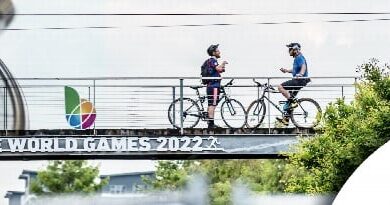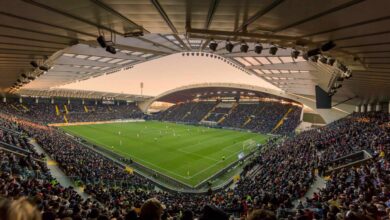
Already at the candidature phase, Paris 2024 committed to reducing the Games carbon footprint by half compared to previous editions. A carbon budget was set which includes all Games planning and operations – from construction to energy and transport, catering and procurement.
- Targeting a 50 per cent reduction in carbon emissions compared to the average of London 2012 and Rio 2016, Paris 2024 has addressed the broadest category of emissions, also covering the indirect footprint of the Games (scope 3 emissions) such as spectator travel. This means that Paris 2024 will offer the first Olympic Games aligned with the Paris Agreement on Climate Change, adopted in 2015.
- Paris 2024 also proactively calculated its “material footprint” – a first in the history of the Olympic and Paralympic Games. Venue by venue, the organisers created a detailed map of required resources, aiming to minimise them and control their life cycle before, during and after the Games. From spectator seating to tents, beds, chairs, tables and even tennis balls – every asset has been meticulously planned.
- The Paris 2024 organisers have also avoided generating carbon emissions thanks to an innovative energy model. In addition to using 100 per cent renewable energy during the Games, Paris 2024 is minimising the use of diesel generators. The few generators that will have to be used will be powered by biofuel, H2 or batteries. All venues will be connected to the grid to avoid the use of temporary energy solutions.
- In addition, Paris 2024 developed a unique methodology for analysing and reducing the Games’ impact on biodiversity and translated this into the design of more sustainable temporary venues.2. Reducing, renting and reusing
Integrated into every level of the organisation, Paris 2024’s circular economy strategy is based on three key principles: organising the Games with fewer resources, making better use of these resources and ensuring the second life of resources after the Games – before the event even starts.
- A total of 95 per cent of the Paris 2024 competition venues will be pre-existing or temporary. The rest have been built using low-carbon construction methods.
- The Aquatics Centre –is designed to serve the local Seine-Saint-Denis community long after the Games. The Centre will largely rely on energy provided by 4,680 square metres of solar panels installed on its rooftop. All seats in the Centre are made from recycled local plastic waste. Wood is at the heart of the building, helping to reduce emissions from construction.
- The principle of reduction also applies to the interior design of the venues. Tents, chairs, computers and sports equipment – Paris 2024 has reduced and encouraged shared use whenever possible. This approach has made it possible, for example, to reduce the amount of furniture needed for the Games from the initially estimated 800,000 items to 600,000.
- Out of two million pieces of sports equipment, three-quarters will be rented or provided by sports federations. More than three-quarters of the electronic equipment such as screens, computers and printers are also rented. The same is true for all the stands, tents and bungalows.
- Thanks to their innovative sourcing strategy, the organisers confirm that 90 per cent of the six million assets will be taken back and reused by partners and The organisers are now defining the second-life plan for the remaining 10 per cent of goods.3. Regeneration
In line with the IOC’s Olympic Agenda 2020, the French authorities aim to leverage the Paris 2024 Games to achieve long-term improvements in the living conditions of the local community, particularly in the northeastern suburb, Seine-Saint-Denis.
- The Aquatics Centre will provide a multi-sports hub for the local community, where currently one in two 11-year-olds does not know how to swim. It will include swimming, climbing and fitness facilities, and areas for individual and team sports.
- Conceived as an eco-neighbourhood, the Olympic Village will be transformed after the Games into a new residential and business district, providing workplaces for 6,000 people and apartments for an additional 6,000. A quarter of these residences will be reserved for public housing, catering to 40 per cent of the current residents in Saint-Denis who rely on it. Another third will be rented out as affordable housing, managed by government-affiliated agencies and offered to students and low-income workers. The addition of restaurants, shops, and leisure centres will rejuvenate the district, where the unemployment rate currently exceeds 20 per cent.
- The installation of underground electricity lines and the redevelopment of the Canal Saint Denis, which borders the Olympic Village, are expected to improve the quality of life for The construction of a noise barrier to the south of the A86 motorway, which traverses the suburb from east to west, is aimed at providing relief to residents affected by traffic noise.
- The Games are also serving as an accelerator to clean the River Seine, with significant investment allocated for pollution remediation, with the aim of enabling all Parisians to enjoy the river from 2025 onwards. The initiative is part of the city’s future climate resilience planning.4. Sustainability on the plate: more plant-based, more local, less plastic
During the Olympic and Paralympic Games, 13 million meals will be delivered in a more responsible manner. Some 120 organisations including farmers, producers, caterers and nutritionists, as well as 200 athletes, were involved in the creation of the Paris 2024 Food vision.
Among other commitments, the organisers are pledging to deliver meals with half the carbon emissions of an average French meal by:
- doubling the proportion of plant-based ingredients and increasing the plant-based options for everyone, including spectators and the workforce
- sourcing 80 per cent of ingredients from local agriculture production, with a quarter produced within 250km of the respective venue
- cutting food waste by better estimating quantities, redistributing, composting or transforming all unconsumed food
- cutting single-use plastic used in catering by half while reusing 100 per cent of catering equipment and infrastructure after the Games. Worldwide Olympic Partner Coca-Cola will install 700 water and soda fountains across all Paris 2024 sites, and the organisers will install free drinking water points. Spectators will be allowed to enter all venues with their own reusable bottles, a notable exception to existing French regulations.5. Transport: shorter distances and lower carbon
The Paris 2024 organisers have structured the Games to leverage an extensive existing public transport network, to be reinforced by more than 400km of new bike lanes.
- More than 80 per cent of the Olympic venues are situated within 10km of the Olympic Village, minimising travel time for athletes.
- All venues are accessible by public transport. Public transport operators plan to expand the bus, metro and train services in the Paris region by 15 per cent compared to regular summer traffic.
- The vehicle fleet catering to athletes and the accredited participants is set to include electric, hybrid and hydrogen-powered vehicles provided by Worldwide Olympic Partner Toyota. In an effort to further reduce impact, the fleet used will be optimised, with about 40 per cent fewer vehicles compared to previous Games.
For more information click here.







